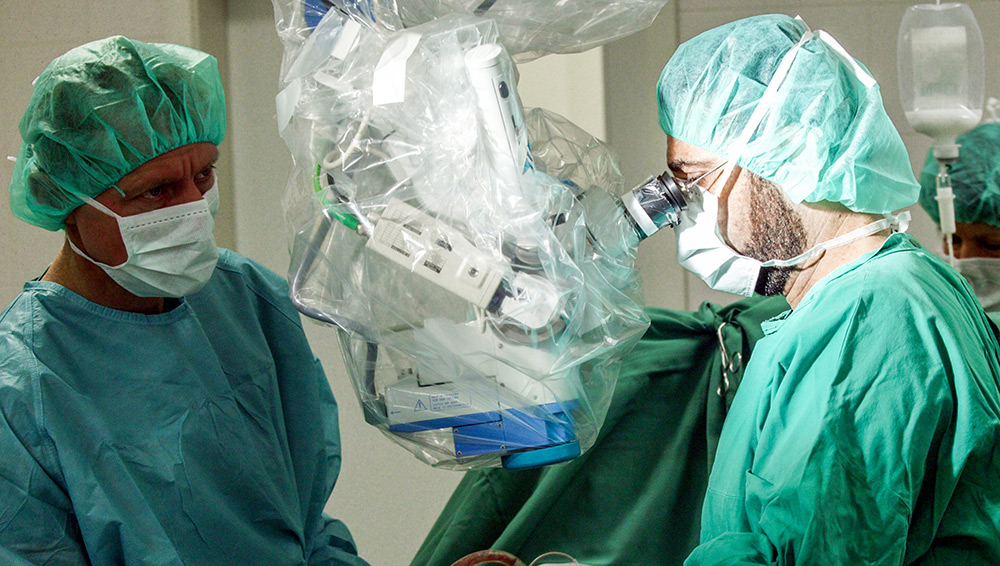What is microsurgery?
Even if everyone has heard this word before, they keep wondering: What is microsurgery actually? Well, the word itself can help you to understand its meaning: micro means 'small', seriously small! Everything is small: the incision and the instruments we work with. Microsurgery is a surgical technique that has developed, among other things, from "minimal invasive surgery" (surgical procedures with the least trauma). This method not only improves the therapeutic rate of success but keeps the surgical tissue damage in narrower limits. The surgeon works with a greatly enlarged visual aid: light microscopes are used. The big and crucial difference between minimally invasive surgery and conventional surgery is the type of access. In conventional large surgery, a 'large incision' is made to reach the surgical field. In microsurgery we access gently. That is - the surgical procedure is not performed under direct vision, but by placing a probe for the introduction of special instruments under microscope guidance. This type of surgery ensures the reduction of trauma to access and surgery.
When is it a promising therapy?
Spine and spinal surgery has been THE pillar of neurosurgery for decades. It can treat degenerative changes, tumors, wounds related to inflammation and diseases of the entire spine or spinal cord. Therefore, you should trust a neurosurgeon if you (or your family doctor) think that the causes of your problems (pain, paralysis, deafness, etc.) are in the spine area. Here, an indication can be developed for a microsurgical procedure, in the case of disc herniation, stenosis, tumors and cysts, which press on the nerves and spinal cord and cause neurological dysfunctions. Although cysts are nothing more than fluid-filled structures, they can cause pain like a herniated disc. In tumors, we distinguish whether they are located inside or outside the spinal cord (intra- / extramedullary), whether they are benign or malignant. Both groups are easy to treat micro-surgically. In order to prevent the progression of the deficits, it is necessary to operate in order to expand the space for the nerve roots and for the spinal cord.
Operation procedure - microsurgery on the thoracic or lumbar spine
In prone position and under general anesthesia, the operation begins with an incision of few centimeters in the middle of the back. Our fine instruments will allow us to reach the spinal canal and remove possible herniation and enlarge the spinal canal by removing bony outgrowths (calcifications) or cysts. Similarly, spinal tumors: rare diseases that can be benign as well as malignant. Again, it is about removing the tumor tissue, without damaging the spinal cord or the nerve tracts. During the procedure, the motor and sensory nerves of the spinal cord are continuously monitored. With our surgical instrument (this can include a laser - with it we can destroy residual tumor cells that we cannot separate with other instruments) we shrink the tumor gradually from the healthy spinal cord. The most common benign spinal tumors in the spinal canal are called meningiomas. We can almost always remove them completely, so that in the future it will not cause neurological deficits. Diagnostics should not be forgotten: We ideally record the tumor via a detailed clinical examination and magnetic resonance imaging (MRI) with or without contrast agent in three levels and an X-ray of the spine. In all cases we infiltrate the surgical field with anti-scar gel to minimize the possibility of post-surgical adhesions. In cases of disc hernia we close the defect of fibrous annulus to minimize the possibility of disc hernia recurrence.
Right after the operation
The first step after surgery is the recovery room, in which your health conditions are monitored and where you probably will take the necessary dose of medication. After that - just a few hours - you will be accompanied into your bedroom. Bed rest is necessary. If you get a visit, do not let yourself be overstrained, your body needs to rest. And the surgical scar - no matter how tiny - has to heal, infections must be avoided.
Post-operative days
The minimally invasive surgery methods reduce the hospital stay. Of course, it depends on the extent of the hernia, the stenosis of the tumor or the cyst - but in principle: One day after the operation, patients can walk - the overall hospital stay is 8-12 days. In the fewest cases there are rehab measures under inpatient conditions. Before discharge they will receive detailed indications by their doctor.
Advantages/Complications - microsurgery is characterized by advantages
Whether removing of disc hernia, enlarging the spinal canal because of stenosis, removing cysts, or a tumor surgery - all treatments are possible micro surgically. The surgical microscope gives us in the depth excellent visibility - in principle, every anatomical detail can be recognized. For the surgery itself special micro-instruments have been developed, which are constantly being improved. This gives us the opportunity to deal with so precisely that a larger tissue trauma can be avoided.
This micro-surgery creates benefits for the patient that you cannot overestimate. Tumors can be completely removed during microsurgical intervention, so that usually a special treatment (radiation or chemo) is not required. Basically, wound heals quickly; postoperative pain and infection risks are reduced. Likewise, the feared scarring - that's because less tissue is destroyed. Last but not least: in the classical sense, Patients can walk much earlier than when major surgeries are performed, this allows them to return to work very soon.
The Avicenna Clinic in Berlin is always willing to help you
Since the year 2001, the Avicenna Clinic is based in Berlin. Our doctors have at least 25 years of international experience in their respective fields (neurosurgery, spinal surgery, anesthesia, and orthopedics).
If you have severe back pain, a herniated disc or a suspected herniation, please contact us using the following information:


